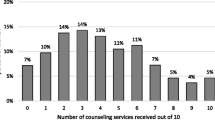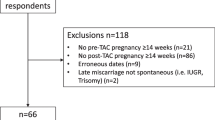Abstract
Objective
To assess the utilization of SCC implemented in southern India and the effect on SCC utilization of face-to-face verbal education versus video-based content delivery.
Methods
The study included newborns with postnatal age of less than 2 wk at discharge. Mothers were administered SCCs and provided standardized verbal or video health education based on the time-period of enrollment. Home based monitoring of stool color and return of SCC on postnatal day 21 was advised. Telephone surveys were conducted to identify SCC use among families that did not return the SCC by post.
Results
Of the 2254 newborns enrolled, 1130 were in the verbal-counseling group and 1124 in the video-counseling group. No newborns with pale stools and biliary atresia were identified. SCC return rates were 3.8% and 2.8%. Comparing the verbal and video-counseling groups, there were no differences in the conservative (81.8% vs. 81.5%) and optimistic estimates (97.1% vs. 97.3%) of SCC utilization rates. Mothers with better educational status had higher optimistic estimates of SCC utilization.
Conclusions
The use of a validated SCC in Tamil with standardized information delivery leads to good utilization rates in southern India, with video content delivery being as effective as face-to-face verbal content delivery. SCC return by post is not a feasible mode of identification of card use.
Trial Registration
The study is registered under Clinical Trials Registry - India (CTRI/2018/01/011285).

Similar content being viewed by others
References
Sokol RJ, Shepherd RW, Superina R, Bezerra JA, RobuckP, Hoofnagle JH. Screening and outcomes in biliary atresia: summary of a national institutes of health workshop. Hepatology. 2007;46:566–81.
Mathiyazhagan G, Jagadisan B. Referral Patterns and Factors Influencing Age at Admission of Infants with Cholestasis in India. Indian J Pediatr. 2017;84:591–6.
Matsui A, Ishikawa T. Identification of infants with biliary atresia in Japan. Lancet. 1994;343:925.
Gu YH, Matsui A. long-term native liver survival in infants with biliary atresia and use of a stool color card: case-control study. Pediatr Int. 2017;59:1189–93.
Chen SM, Chang MH, Du JC, et al. Screening for biliary atresia by infant stool color card in Taiwan. Pediatrics. 2006;117:1147–54.
Hsiao CH, Chang MH, Chen HL, et al. Universal screening for biliary atresia using an infant stool color card in Taiwan. Hepatology. 2008;47:1233–40.
Lee M, Chen SC, Yang HY, Huang JH, Yeung CY, Lee HC. Infant stool color card screening helps reduce the hospitalization rate and mortality of biliary atresia: a 14-Year nationwide cohort study in Taiwan. Medicine (Baltimore). 2016;95:e3166
Zheng J, Ye Y, Wang B, Zhang L. Biliary atresia screening in Shenzhen: implementation and achievements. Arch Dis Child. 2020;105:720–3.
Woolfson JP, Schreiber RA, Butler AE, et al. Province-wide biliary atresia home screening program in britishcolumbia: evaluation of first 2 years. J Pediatr Gastroenterol Nutr. 2018;66:845–9.
Borgeat M, Korff S, Wildhaber BE. Newborn biliary atresia screening with the stool colour card: a questionnaire survey of parents. BMJ Paediatr Open. 2018;2:e000269.
Loevinsohn BP. Health education interventions in developing countries: a methodological review of published articles. Int J Epidemiol. 1990;19:788–94.
Pavithra G, Kumar SG, Roy G. Effectiveness of a community-based intervention on nutrition education of mothers of malnourished children in a rural coastal area of South India. Indian J Public Health. 2019;63:4–9.
Oli N, Vaidya A, Eiben G, Krettek A. Effectiveness of health promotion regarding diet and physical activity among Nepalese mothers and their young children: The Heart-health Associated Research, Dissemination, and Intervention in the Community (HARDIC) trial. Glob Health Action. 2019;12:1670033.
Adhisivam B, Vishnu Bhat B, Poorna R, Thulasingam M, Pournami F, Joy R. Postnatal counselling on exclusive breastfeeding using video - experience from a tertiary care teaching hospital. South India J Matern-Fetal Neonatal Med. 2017;30:834–8.
Hiremath P, Chakrabarty J, Sequira L. Video-assisted education on knowledge and practices of housewives towards prevention of Dengue Fever at Gokak Taluk, Karnataka. India Int J Health Promot Educ. 2019;5:259–67.
Mutanda JN, Waiswa P, Namutamba S. Community-made mobile videos as a mechanism for maternal, newborn and child health education in rural Uganda; a qualitative evaluation. Afr Health Sci. 2016;16:923–8.
Shoemaker SJ, Wolf MS, Brach C. Development of the patient education materials assessment tool (PEMAT): a new measure of understandability and actionability for print and audiovisual patient information. Patient Educ Couns. 2014;96:395–403.
Harpavat S, Garcia-Prats JA, Shneider BL. Newbornbilirubin screening for biliary atresia. N Engl J Med. 2016;375:605–6.
Powell JE, Keffler S, Kelly DA, Green A. Population screening for neonatal liver disease: potential for a community-based programme. J Med Screen. 2003;10:112–6.
Matsui A. Screening for biliary atresia. Pediatr Surg Int. 2017;33:1305–13.
Lam L, Musaad S, Kyle C, Mouat S. Utilization of reflex testing for direct bilirubin in the early recognition of biliary atresia. Clin Chem. 2017;63:973–9.
Masucci L, Schreiber RA, Kaczorowski J, Collet JP, Bryan S. Universal screening ofnewborns for biliary atresia: cost-effectiveness of alternative strategies. J Med Screen. 2019;26:113–9.
Morinville V, Ahmed N, Ibberson C, et al. Home-based screening for biliary atresia using infant stool color cards in Canada: Quebec feasibility study. J Pediatr Gastroenterol Nutr. 2016;62:536–41.
Schreiber RA, Masucci L, Kaczorowski J, et al. Home-based screening for biliary atresia using infant stool colour cards: a large-scale prospective cohort study and cost-effectiveness analysis. J Med Screen. 2014;21:126–32.
Mogul D, Zhou M, Intihar P, Schwarz K, Frick K. Cost-effective analysis of screening for biliary atresia with the stool color card. J Pediatr Gastroenterol Nutr. 2015;60:91–8.
Bag S, Datta M. Evaluation of mother and child protection card entries in a rural area of West Bengal. Int J Community Med Public Health. 2017;4:2604–7.
Gibson DG, Ochieng B, Kagucia EW, et al. Mobile phone-delivered reminders and incentives to improve childhood immunisation coverage and timeliness in Kenya (M-SIMU): a cluster randomised controlled trial. Lancet Glob Health. 2017;5:e428–38.
Shinde K, Rani U, Kumar PN. Assessing the effectiveness of immunization reminder system among nursing mothers of South India. Res J Pharm Technol. 2018;11:1761–7.
Messeri P, Cantrell J, Mowery P, Bennett M, Hair E, Vallone D. Examining differences in cigarette smoking prevalence among young adults across national surveillance surveys. PLoS One. 2019;14:e0225312.
Pandey VK, Aggarwal P, Kakkar R. Modified BG Prasad’s socio-economic classification-2018: the need of an update in the present scenario. Indian J Community Health. 2018;30:82–4.
Acknowledgements
The authors thank the Health Promotion Administration, Ministry of Health and Welfare, Taiwan and Prof. Mei-Hwei Chang, College of Medicine, National Taiwan University for authorizing the Stool Color Card.
Funding
The study was funded by an intramural grant (JIP/Res/Intramural/phs2/2017–18).
Author information
Authors and Affiliations
Contributions
PSK collected the data, analyzed and interpreted the data, prepared the manuscript; BJ conceptualized and designed the study, analyzed and interpreted the data, prepared the manuscript; SL designed the study and interpreted the data; NP interpreted the data; All authors contributed to the manuscript and approved the final manuscript. BJ is the guarantor of this paper.
Corresponding author
Ethics declarations
Ethical Clearance
The study had been approved by the institutional ethics committee that complies with international standards and is registered with the Government of India (JIP/IEC/2017/0248).
Conflict of Interest
None.
Additional information
Publisher's Note
Springer Nature remains neutral with regard to jurisdictional claims in published maps and institutional affiliations.
Supplementary Information
Below is the link to the electronic supplementary material.
Rights and permissions
About this article
Cite this article
Karri, P.S., Jagadisan, B., Lakshminarayanan, S. et al. Biliary Atresia Screening in India—Strategies and Challenges in Implementation. Indian J Pediatr 89, 133–140 (2022). https://doi.org/10.1007/s12098-021-03862-x
Received:
Accepted:
Published:
Issue Date:
DOI: https://doi.org/10.1007/s12098-021-03862-x




